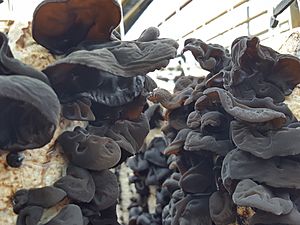Heimuer facts for kids
Quick facts for kids Heimuer |
|
|---|---|
 |
|
| Cultivated Auricularia heimuer | |
| Scientific classification |
Auricularia heimuer is a special type of fungus often called black wood ear or heimuer in Chinese. It's a very popular ingredient in many Chinese dishes, like hot and sour soup. People in China grow a lot of this mushroom for food, and it's a huge business! It's also used in traditional Chinese medicine. For a long time, people thought this mushroom was the same as a European one, but scientists later found out it's actually a unique species found only in East Asia.
Contents
Discovering the Black Wood Ear
Scientists officially named Auricularia heimuer in 2014. They used modern DNA research to study different types of Auricularia mushrooms in China. This research helped them understand how these mushrooms are related.
A New Species Identified
The studies showed that the mushroom commonly grown in China was not the same as the European Auricularia auricula-judae. Instead, it was a separate and special species. They named it Auricularia heimuer after its popular Chinese name, "heimuer" (黑木耳), which means "black wood ear."
What Does the Black Wood Ear Look Like?
The Auricularia heimuer mushroom has a unique look. Its body is soft and jelly-like, shaped a bit like an ear. It usually attaches to wood from the side.
Size and Color
These mushrooms can grow quite large, up to 120 millimeters (about 4.7 inches) across. They are also about 1.5 millimeters (0.06 inches) thick. When fresh, the top side is light brown to reddish-brown. When it dries, it turns grey-brown. Mushrooms grown on farms often have a darker color. The underside, where the spores are made, feels smooth. It's usually a pinkish-tan color when fresh and turns purplish-grey when dry.
Where Does the Black Wood Ear Grow?
Auricularia heimuer is a type of mushroom that helps wood rot. This means it grows on dead trees. You can often find it on standing or fallen broadleaf trees.
Natural Habitat
In the wild, it grows most often on oak trees. Sometimes, it can be found on other types of broadleaf trees too.
Cultivation
When people grow this mushroom, they sometimes use broadleaf logs. More often, they grow it on special mixes that contain sawdust.
Geographic Distribution
This mushroom is found in cooler areas of northern China. It also grows in the Russian Far East, Korea, and Japan.
How People Use Black Wood Ear Mushrooms
The black wood ear mushroom is very popular, especially in cooking. It has been used for a very long time in different cultures.
Cooking with Black Wood Ear
China: People in China have used a type of Auricularia mushroom, likely A. heimuer, for over 2,000 years. It was mentioned in old Chinese medical books. People started farming these mushrooms as early as the Tang Dynasty (618–907 AD). An old saying from that time suggests how to grow them: "put the steamed bran on logs, cover with straw, Wood Ear will grow."
Today, this mushroom is a common ingredient in many savory dishes. It's also cooked and served as a salad with vegetables and tasty sauces. Some people even use a soup with this mushroom to help with colds and fevers. This is because they believe it helps cool the body down. In 2013, China produced a huge amount of Auricularia mushrooms, about 4.75 billion kilograms (fresh weight)! This was worth about four billion US dollars.
Japan: In Japan, this mushroom is called "kikurage," which means "wood jellyfish." It's often shredded and used as a topping for ramen noodles.
Korea: In Korea, the cultivated mushroom is known as "heung-mogi." It's commonly used in a popular dish called japchae.

